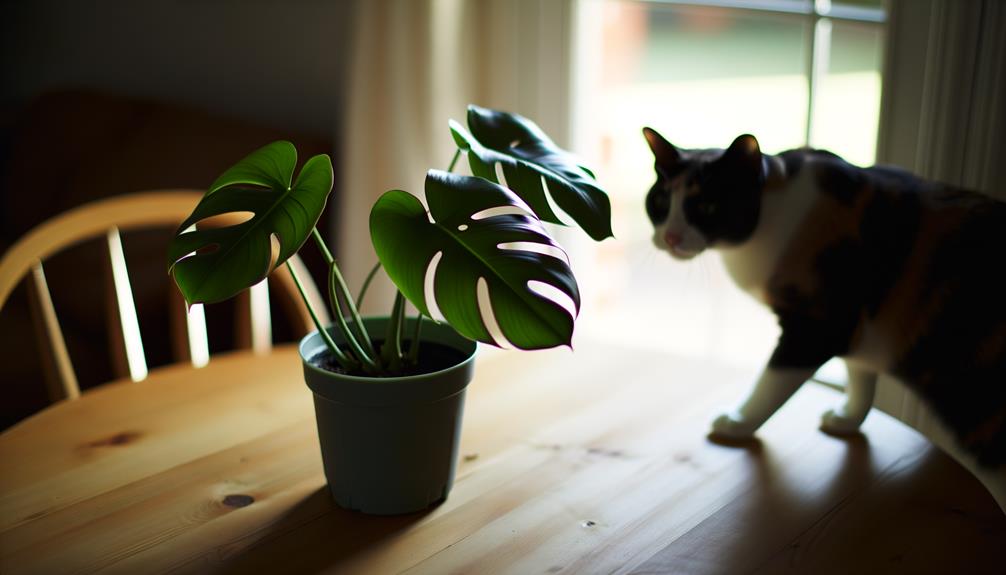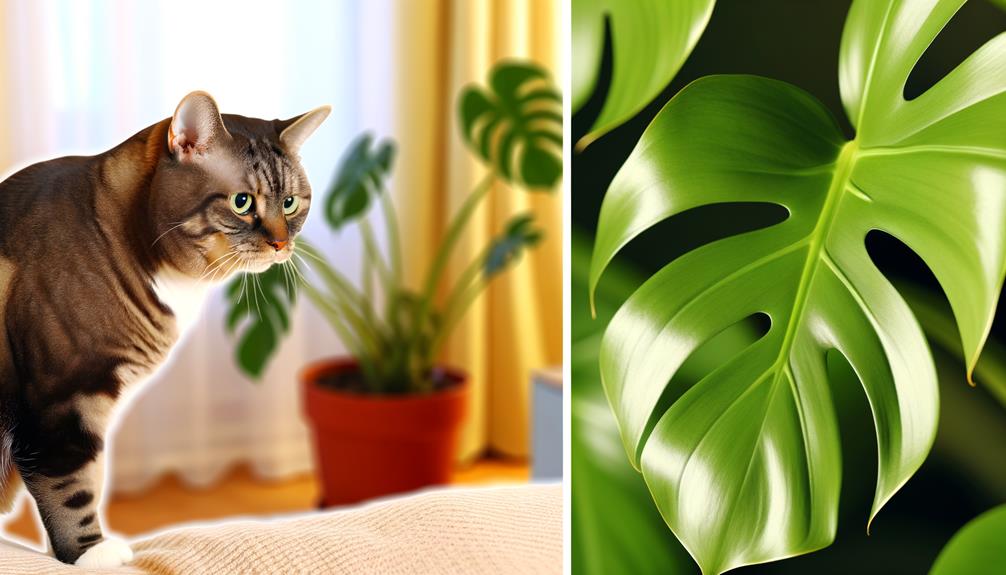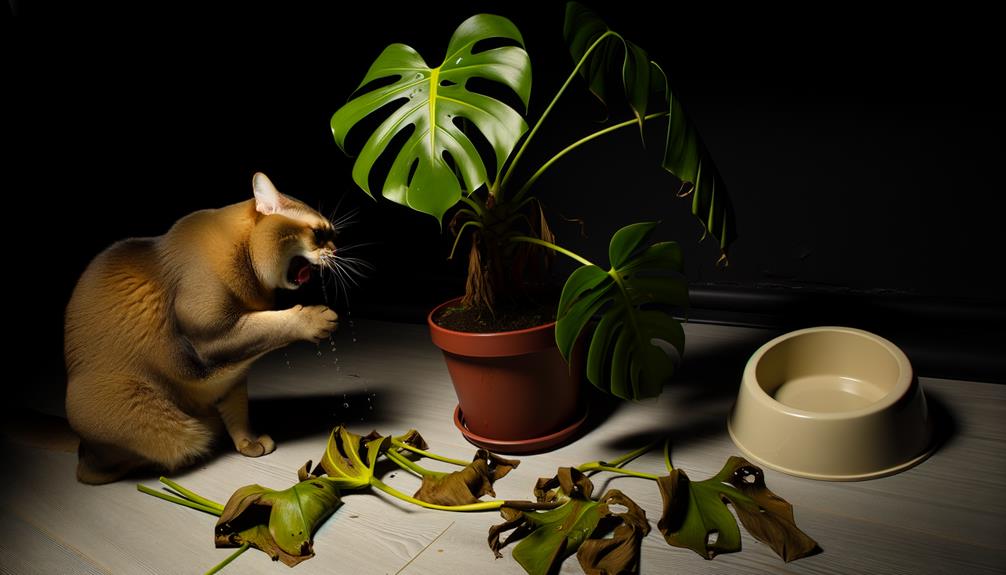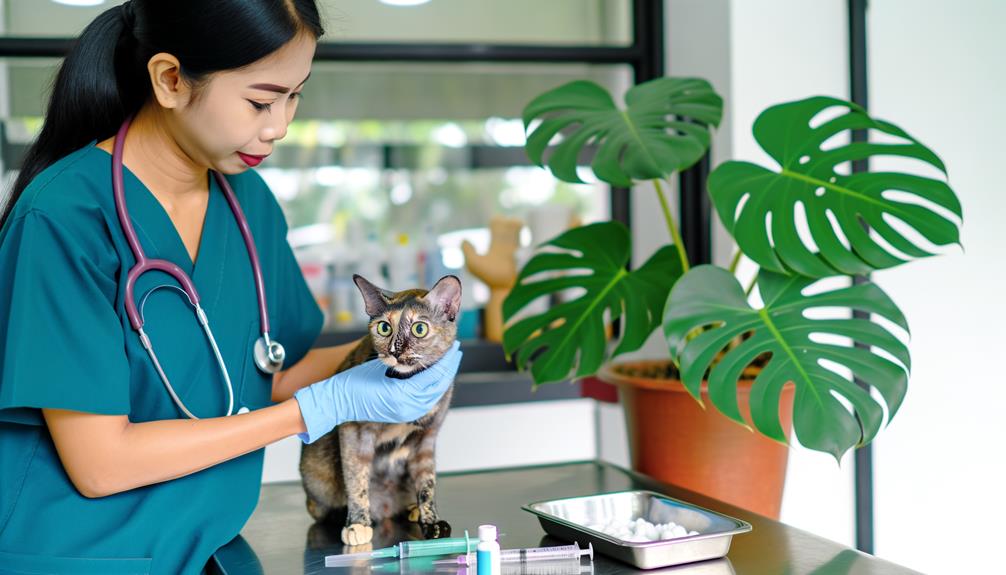Monstera Minima Toxic to Cats: What You Should Know!
Monstera Minima is toxic to cats due to insoluble calcium oxalate crystals and proteolytic enzymes in its sap. Even minimal exposure can cause vomiting, diarrhea, excessive drooling, and difficulty swallowing.
Immediate veterinary intervention is vital for managing symptoms, which may include administering activated charcoal and intravenous fluids. Preventing access to this plant is essential to safeguarding your feline.
Understanding the toxicity of Monstera Minima can help you take the necessary precautions to protect your pet and keep them safe. Discover more about creating a cat-friendly environment.

Key Takeaways
- Monstera minima contains insoluble calcium oxalate crystals, which are highly toxic to cats.
- Symptoms of Monstera minima toxicity in cats include drooling, vomiting, and difficulty swallowing.
- The plant’s sap has proteolytic enzymes that increase tissue damage in cats.
- Immediate veterinary care is crucial for treating Monstera minima toxicity in cats.
- Keeping Monstera minima out of reach prevents poisoning and ensures cat safety.
Understanding Monstera Minima

Monstera minima, scientifically known as Rhaphidophora tetrasperma, is a tropical plant often mistaken for its larger cousin, Monstera deliciosa. You’ll find it characterized by its distinctive, fenestrated leaves, making it a popular choice for indoor horticultural enthusiasts.
Native to Southern Thailand and Malaysia, it thrives in humid environments with indirect light. When cultivating Monstera minima, make sure you provide well-draining soil and maintain consistent moisture levels to mimic its natural habitat.
This plant’s rapid growth can require frequent pruning and support structures to manage its climbing nature. Understanding its specific care requirements is essential for peak health and aesthetic appeal.
Proper cultivation practices will help your Monstera minima thrive, contributing to a lush indoor space.
Toxic Compounds in Monstera Minima
Containing insoluble calcium oxalate crystals, Rhaphidophora tetrasperma poses a significant toxicity risk to cats. These needle-shaped crystals can penetrate soft tissues in the mouth, throat, and gastrointestinal tract.
When your cat chews on any part of the plant, these crystals are released, causing intense irritation. The plant’s sap contains proteolytic enzymes that can exacerbate tissue damage by breaking down proteins. It’s a dual threat – mechanical injury from the crystals and chemical injury from the enzymes.
Research indicates that even minimal exposure can trigger adverse reactions. Understanding this biochemical composition helps you appreciate the plant’s inherent dangers. Always be cautious and make sure that such toxic plants are kept well out of your cat’s reach.
Symptoms of Toxicity in Cats

When your cat ingests Monstera Minima, you might observe clinical symptoms such as:
- vomiting and diarrhea,
- excessive drooling, and
- difficulty swallowing.
These symptoms are indicative of oral and gastrointestinal irritation caused by calcium oxalate crystals.
Immediate veterinary intervention is essential to manage these toxic effects effectively.
Vomiting and Diarrhea
Ingestion of Monstera Minima by cats often leads to gastrointestinal symptoms such as vomiting and diarrhea due to the plant’s toxic compounds. These symptoms are primarily caused by insoluble calcium oxalates and proteolytic enzymes present in the plant. When consumed, these compounds irritate the gastrointestinal tract, leading to inflammation and subsequent vomiting.
Diarrhea results from the body’s attempt to expel the irritants rapidly. Clinical signs can appear within a few hours post-ingestion and may vary in severity based on the amount consumed and the cat’s size. It’s important to monitor your cat closely if you suspect ingestion, as prompt veterinary intervention can mitigate severe outcomes and guarantee appropriate management of these distressing symptoms.
Excessive Drooling
Beyond gastrointestinal symptoms, Monstera Minima toxicity in cats can also manifest as excessive drooling, driven by the plant’s irritant compounds affecting the oral mucosa.
When your cat chews or ingests parts of this plant, calcium oxalate crystals are released. These microscopic, needle-like structures embed in the tissues of the mouth, causing intense irritation and pain. This irritation leads to a hypersalivation response, as your cat’s body tries to expel the irritants.
You’ll notice your cat exhibiting constant drooling, often accompanied by pawing at the mouth, vocal distress, and refusal to eat. It’s vital to recognize this symptom early, as prolonged exposure can exacerbate the discomfort and potentially lead to further complications.
Immediate veterinary attention is recommended.
Difficulty Swallowing
Your cat may experience difficulty swallowing due to the intense oropharyngeal irritation caused by Monstera Minima’s calcium oxalate crystals. These microscopic crystals embed into the mucous membranes of the mouth, throat, and esophagus, leading to painful inflammation and swelling. Recognizing this symptom is vital for prompt veterinary intervention.
Clinically, you might observe:
- Pawing at the mouth: Your cat may repeatedly touch its mouth due to discomfort.
- Gagging or choking sounds: Audible distress can indicate severe irritation.
- Decreased appetite: Painful swallowing often results in reduced food and water intake.
- Increased salivation: Excessive drooling can accompany difficulty swallowing.
Understanding these symptoms enables you to act quickly, ensuring your cat receives the necessary care.
Immediate Actions After Ingestion
If you suspect your cat has ingested Monstera Minima, promptly identify symptoms such as oral irritation, drooling, or vomiting.
Contact your veterinarian immediately for professional guidance and potential treatment options.
Administer any recommended first aid measures to stabilize your cat while awaiting veterinary care.
Identify Symptoms Quickly
Upon ingestion, it’s crucial to swiftly recognize symptoms like drooling, vomiting, and difficulty swallowing in your cat. Immediate identification of these symptoms can greatly impact the outcome.
Look for:
- Oral irritation: Signs include pawing at the mouth, excessive drooling, and vocalization.
- Gastrointestinal upset: Watch for vomiting, diarrhea, and decreased appetite.
- Respiratory distress: Labored breathing or wheezing indicates severe complications.
- Swelling: Any facial swelling, particularly around the mouth or throat, requires urgent attention.
Quick action is critical. These symptoms suggest the ingestion of toxic substances, such as those found in Monstera Minima. Recognizing these signs early can lead to prompt treatment, minimizing potential harm to your cat.
Always stay vigilant and observant.
Contact Veterinarian Immediately
Recognizing these symptoms requires reaching out to your veterinarian immediately for professional guidance and potential interventions. Swift communication with your vet guarantees prompt assessment of your cat’s condition.
Provide detailed information about your cat’s symptoms and the ingestion timeline. Your veterinarian may ask about the amount ingested and your cat’s weight to calculate potential toxicity levels. They could instruct you to bring your cat in for an examination or recommend monitoring specific signs at home.
Quick professional intervention is crucial in mitigating potential complications, such as oral irritation, excessive drooling, or gastrointestinal distress. Immediate veterinary advice can greatly enhance your cat’s prognosis, ensuring targeted treatment and reducing the risk of severe reactions.
Trust your veterinarian’s expertise to guide you through this critical time.
Provide Necessary First Aid
Following the ingestion of Monstera Minima, promptly administer first aid to mitigate the potential adverse effects on your cat’s health. Swift action can alleviate symptoms and improve prognosis.
Here’s what you should do:
- Rinse the Mouth: Use a syringe or dropper to rinse your cat’s mouth with water to remove plant residues.
- Hydrate: Encourage your cat to drink water, which can help dilute toxins and prevent dehydration.
- Monitor Symptoms: Observe for signs of distress, such as drooling, vomiting, or difficulty breathing.
- Administer Activated Charcoal: If advised by your veterinarian, give activated charcoal to absorb toxins.
These steps are essential. However, always contact your veterinarian immediately for further guidance and potential treatments.
Veterinary Treatments Available

Immediate veterinary intervention is vital when a cat has ingested Monstera Minima, with treatments often involving decontamination, symptomatic support, and monitoring for complications.
Activated charcoal may be administered to bind toxins and reduce absorption. Intravenous fluids help maintain hydration and electrolyte balance, while antiemetics control vomiting. Pain management, typically with analgesics, is essential due to oral and gastrointestinal irritation.
In severe cases, hospitalization guarantees continuous monitoring for renal failure or respiratory distress. Blood tests and urinalysis can assess organ function and guide further treatment.
Quick action and adherence to veterinary advice greatly enhance recovery prospects. Remember, early detection and professional care are key to mitigating the toxic effects of Monstera Minima ingestion in cats.
Preventing Plant Poisoning
To minimize the risk of plant poisoning in cats, it’s crucial to adopt proactive strategies such as removing toxic plants like Monstera Minima from your home and providing safe alternatives. Prioritize vigilance and preventive measures to safeguard your feline’s safety.
Key steps include:
- Identify and eliminate: Conduct a thorough audit of all plants in your home to identify and eliminate toxic varieties.
- Educate yourself: Familiarize yourself with common toxic plants and their symptoms of poisoning.
- Secure plants: Place remaining non-toxic plants out of reach or use deterrent sprays to discourage chewing.
- Regular vet visits: Schedule routine veterinary check-ups to monitor your cat’s health and catch any potential issues early.
Cat-Safe Plant Alternatives

When picking plants for a cat-friendly home, consider options like spider plants, Boston ferns, and parlor palms, which are non-toxic and safe for your feline companions.
Spider plants (Chlorophytum comosum) not only flourish in various light conditions but also purify air effectively.
Boston ferns (Nephrolepis exaltata) offer lush greenery and are renowned for their humidity-boosting properties, benefiting both you and your cat.
Parlor palms (Chamaedorea elegans) are low-maintenance, only needing occasional watering and indirect sunlight.
These alternatives are supported by evidence from the ASPCA, confirming they don’t present toxicity risks to cats.
Creating a Pet-Friendly Home
Designing a pet-friendly home involves strategically arranging your space to minimize hazards and promote the well-being of your furry companions. It’s essential to identify and mitigate potential risks, especially concerning toxic plants like Monstera Minima.
Evidence-based practices suggest the following steps:
- Replace toxic plants: Substitute harmful flora with non-toxic, pet-safe alternatives.
- Secure chemicals: Store cleaning agents, pesticides, and medications in locked cabinets.
- Create safe zones: Designate specific areas where pets can play and rest without encountering hazards.
- Use pet-friendly furniture: Opt for materials that are durable and non-toxic, considering both comfort and safety.
Conclusion
Just like finding your way through a labyrinth, keeping your cat safe from Monstera Minima requires vigilance and knowledge.
Recognize the hidden dangers within these plants, and act swiftly if your feline friend encounters toxicity.
With the right veterinary treatments and preventive measures, you can guarantee your pet’s well-being.
Opt for cat-safe plants and build a sanctuary where curiosity doesn’t lead to harm.
Your home can be a safe haven, free from toxic botanical threats.






